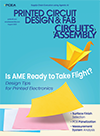SANTA CLARA, CA – Mistakes were made.
That was one of the big takeaways from the keynote address at PCB West this week, in which Wally Rhines, CEO of Mentor, traced the evolution of the CAD industry. In doing so, Rhines also offered a glimpse of where the future might be for ECAD and, by extension, those who use the tools.
In an often-humorous and occasionally poignant hour-long presentation, Rhines recalled the highs and lows of the major PCB CAD firms, past and present, and lessons learned – and often forgotten. Rhines was in a good position to narrate the timeline: He has been the top executive of Mentor since 1993, longer than any other leader in the ECAD space.
In his talk, Rhines also sounded some personal notes. For instance, he recalled working as a semiconductor engineer for Texas Instruments in Texas, where he met a fellow engineer from Digital Equipment. On their first date, he asked if he could see her Pascal compiler. (They’ve now been married for more than 40 years.)
Throughout its five-decade history, the CAD industry has been characterized by the large swallowing the small, often with disastrous results. GE Calma was a case study in how a large company can acquire a small company and inadvertently destroy it. Back in the day, Calma was one of the major CAD tool providers, having devised a way to digitize circuit design, which to that point had been primarily performed by manual tracing. The acquisition by a large company killed it in a matter of months, Rhines said.
Rhines noted how rival Cadence not once but twice almost put it out of business. Mentor used a router developed by Cooper & Chyan Technology (CCT). Some 85% of CCT’s revenue came via Mentor, which incorporated the CCT router into its tool set. CCT decided to sell. After Mentor turned down their $60 million asking price, Cadence bought the company for $480 million. It then quickly terminated the OEM agreement with Mentor.
Faced with the equivalent of competing in a Formula 1 race in a car without an engine, Mentor called Intergraph, which at the time owned the money-losing VeriBest autorouter. It took Rhines all of six days to close the deal, which cost less than $20 million – a fraction of the Cadence-CCT merger – and allowed Mentor to leapfrog into the technology lead.
“Then Mentor repeated the Cadence mistake by buying Innoveda,” Rhines laughed. “The lessons seem to repeat themselves, but no one seems to learn.”
(Ironically, in 2008, Cadence attempted a hostile takeover of Mentor to the tune of $1.5 billion, but Mentor rejected the bid, and later the suitor’s own shaky finances torpedoed the attempt.)
As mergers among the CAD vendors accelerated and consolidation took place, the market converged into three major players: Cadence, Mentor and Zuken.
Ancillary tools for thermal analysis, signal integrity, and other technologies began to pop up. Then their developers would sell to one of the big three. PCB software became more technologically capable. By 1993, Rhines said, “it was clear MCAD and ECAD would converge … and it hasn’t really happened.”
The people haven’t changed, he said. “You can’t make software engineers into hardware engineers, or mechanical engineers into electrical engineers. We needed to create an environment where you could do the tasks without changing the people.”
While the finances of the PCB CAD vendors ebbed and flowed, sometimes due to economy, sometimes for more self-inflicted reasons (Rhines joked about Mentor’s 8.0 tool, which in the five years it took between the initial announcement and its actual release was sometimes referred to as “Mentor Late.Dot.Slow”), the major players have relied on wire harness, automotive and related systems design tools to extend their reach and support their revenue goals. Siemens’ acquisition of Mentor, he said, establishes a full silicon to PCB design to assembly process to end-product modeling and virtual verification flow under one roof. The result was a record year for Mentor in 2017, and in a nod to the past, the firm is increasing its M&A activity to its fastest pace since 2002.
For EDA, is past prologue? After more than two decades in software, Rhines seems to believe it is.













